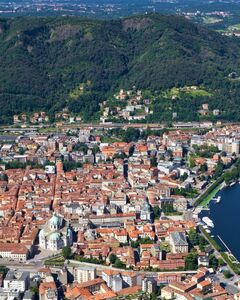
churches near Antica Molina


First mentioned the thirteenth century, but excavations, have unearthed remains of a chapel built in eleventh and the twelfth century and rebuilt in the fifteenth century. The bell tower has been dated to the second half of the eleventh century. A...

Built in the Romanesque period, between the 11 and 12th centuries, but underwent many changes and expansions to its current appearance. It was the first parish church of Molina; over the centuries, the population of this village moved increasingly...
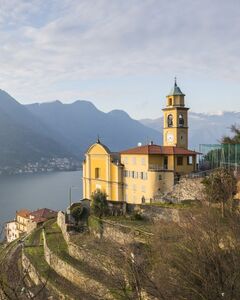
Built between 1723 and 1744 and consecrated by Bishop Albrici Pellegrini in 1764. The façade, in the Baroque style, is characterized by four pilasters and from the portal flanked by two niches and surmounted by a sundial. Above it is the date in...

Nestled in the woods of the Natural Reserve of Valle Bova, the hermitage is available to accommodate individuals, couples, priests, lay people, religious, who want to enjoy moments of silence and prayer....
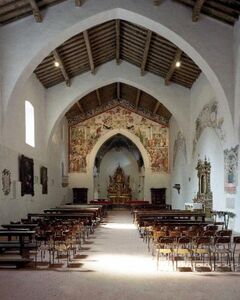
Also known as St. Anthony, as there is a preserved relic of the saint that is exposed to the congregation of the faithful every 17 January. The church was an integral part of the Franciscan convent of Santa Maria degli Angeli, founded in Crevenna at...
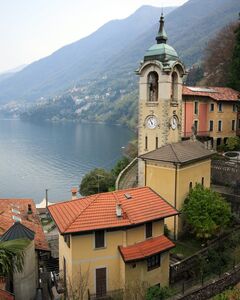
Church built between 1910 and 1931 in Palanzo, a small village above Faggeto Lario. The short hike affords great views of the lake from a a nearby park....
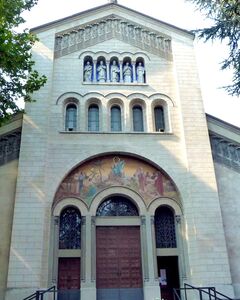
The building was first started between 1908 and 1912. Luigi Dell'Orto, mayor of Cernobbio for almost thirty years, wanted this church to solemnize his wedding with Elizabeth Lucca. After the war, the building was completed thanks to the heirs, in...

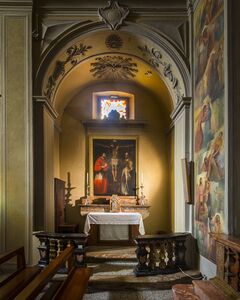
The construction of the church began in 1791 and ended in 1823 requiring the works of several architects: Clemente Isacchi, Giuseppe Pollack, Giuseppe Bovara and Simone Cantoni. The church hosts a crucifixion of 1879 by Mosè Bianchi and a painting...
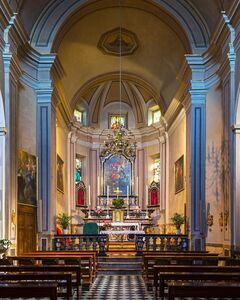
St. George, as with other holy warriors (Michael and Martin) was highly revered by the Lombards. The present church was built in the sixteenth century on the site of a former place of worship; it underwent other changes in following years,...
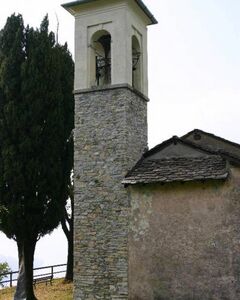
Built in the second half of the sixteenth century, this church was remodeled and expanded in later periods. Distinct for its large columns and the sixteenth round arches on the porch....

The church of Saints Peter and Paul was believed to have been founded in the eleventh century by Bishop Rainald and consecrated in 1095 by Pope Urban II, who was traveling to Clermont-Ferrand to call the first crusade. Over the centuries, the...

The Church of Saints Nazario and Celso is just a short walk away from the waters of Lake Como, near the harbor in the old town of Brienno. Some documents attest to the presence of a church since the end of the thirteenth century, the Romanesque...
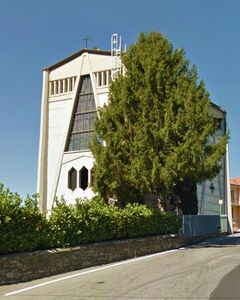
Temple of the Shrine dedicated to Our Lady of the Water Sports Prodigy. In a stormy crossing of the Adriatic, on the night of September 12, 1669, the family of Count Antonio Zancaropulo Berardo escaping from Crete, sought shelter in Venice. During...
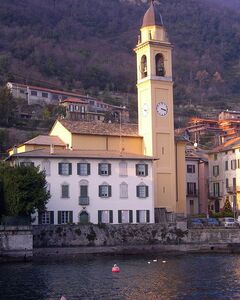
The parish church is located in the center of the country.Built in the seventeenth century, is decorated with prestigious and stucco friezes of Stefano Salterio (XVIII century) and also preserves works of painting and sculpture of the eighteenth...

Situated in the hamlet of Borgo, built on the previous Romanesque building, was the parish from the end of the fifteenth century. A single nave, has suffered repeated rearrangements. Inside frescoes Fiammenghino and an altarpiece of the sixteenth...

Urio, the part of the town that lies south of Carate, is characterized by the Romanesque bell tower of the Saints Quirico and Giulitta church that stands close to the lake. Rebuilt in 1865 from an original Romanesque church with two towers and a...
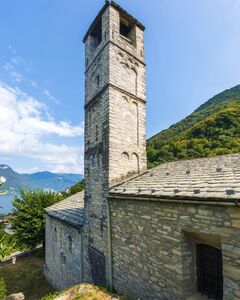

The church of San Vincenzo in Cernobbio is located in the historic part of the town, in front of Tolomeo Gallio square, a few steps away from the lake. We can date the origin of the church back to 1150, a pastoral visit of Bishop Niguarda that took...

Built on location of a church dating back to the 16th century, Santi Epimaco e Girdino was completely rebuilt in the second half of the 18th century. The original parish church is located in the lower part of town, near the lake. For this reason,...
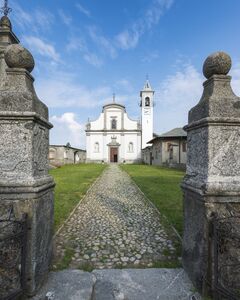
The current building was built on the site previously occupied by an older church: its construction began in 1593 and lasted until the next century (1617), when it became an independent parish. In the eighteenth century underwent a partial...
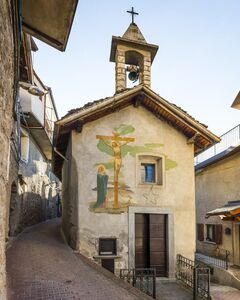
The small chapel is located in the historic center of Veleso, at the intersection of several streets. The façade is decorated with a fresco depicting the Crucifixion....
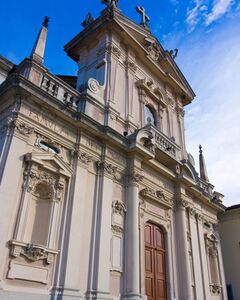
Occupying an enviable position high above the town of Como and Como branch of the lake, the church of Brunate contains a wealth of history and art. The centuries-old history of the church contains beautiful artistic works (the fifteenth-century...
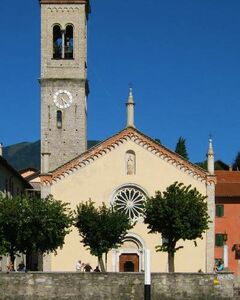
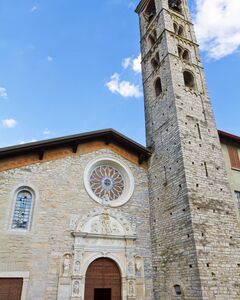
The village contains this interesting church that dates back to the 14th century. It has a fine Romanesque bell tower and a decorated Renaissance portal. An ancient chest behind the altar preserves a precious reliquary, a nail of the Holy Cross....

The church, that stands near the lake, contains interesting frescoes, and the outside is characterized by an open porch to the lake with a double lancetwindow and a tall stone bell tower. It was the church of the community, which remained...
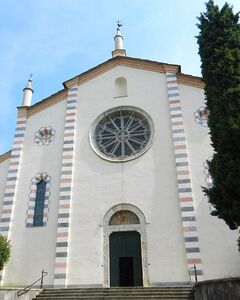
The church was founded in 1300 by two brothers Hermits of St. Augustine from Civilio, a village above Como, on land donated by a family whose members were later buried in front of the presbytery. It is the only example of Cistercian architecture...
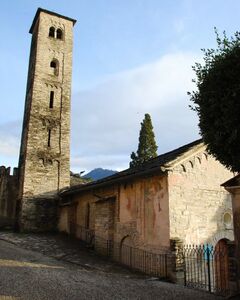
Situated in the hamlet of Vignola, along the ancient Via Regina, it preserves its ancient structure in bare stone decorated with small arches. The exterior has remains of Renaissance and late Gothic frescos. The interior is divided into two naves...

Located in the middle of the walled town, the church was built between the 11th to the end of the 13th century and was possibly the first cathedral in Como. It features a complex planimetry including three short naves, provided with women's...
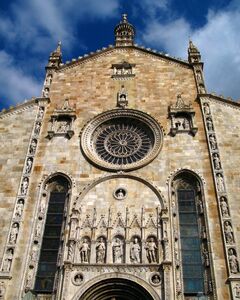
An omni-present feature of Lake Como’s skyline is the Como Cathedral with its white marble facade and imposing dome. The interior is equally spectacular boasting elaborate altar paintings, gargoyles and a magnificent dome. Como Cathedral (Italian:...
Located in Breglia (780m), 7 km from Menaggio, it offers visitors a spectacular view of central Lake Como and the Bellagio peninsula. Inside there is a sculpture of the Madonna, carved in marble....
High on the road is the sanctuary of the Madonna of Peace, erected in 1659 to celebrate the peace of Pirenei, which ended the Thirty Year War between the French and Spaniards. Characteristic is the Romanesque hanging bell (sec. XIII), and in the...
Originally a medieval church (XI century) but many additions and changes have taken place over the centuries. For several years it served as the parish church of Sormano, Caglio and Rezzago. The building, located at a higher level than the street,...
The church dates from around 1614-1617. Noteworthy, are the walls from the outside, consisting of a mixed texture of stone and brick. The interior is richly decorated with frescos and sculpture....
The parish church of St. Abbondio rises isolated on the western side of the village of Mezzegra, with its majestic front facing the lake. It was probably founded in the 12th century in Romanesque style, then rebuilt in 1702 by local emigrants and...
The church is located next to the parish church of SS. Quirico e Giulitta and is accessed by three steps. It dates from the fourteenth century and was enlarged with the construction of two bays in the middle of the sixteenth century. Noteworthy are...
The church of St. George is located in Bellagio, next to City Hall. It is contemporary with the Basilica of St. James, dating back to ' XI - XII century (dated between 1080 and 1120). Originally the apse and altar were facing east; but then moved...
With origins in the 17th century and remodelled later with an image of the patron saint on the facade by Bernardino Barelli. Noteworthy are the altar sculptures, frescoes, stucco, oil paintings, a Renaissance tabernacle and the wooden reliquary...
Although early in Christian origin, this church collapsed due to erosion at the end of the 16th century and was completely rebuilt in the Baroque style. Of note, are lavish frescos, sculpture wooden inlaid furniture and a stone font presbytery....
A series of chapels depicting Christ’s final journey to Mount Golgotha. The traditional 14 stations have been added to with a 15th dedicated to Our Lady of Sorrows and are located in a rectangular square in front of the parish church, dedicated to...
The church stands on a hill, away from residential areas; It can be reached via a path through the woods and ends close to the facade; it is accessed from the main entrance facade and a second entrance on the eastern side. The church has suffered...
Built towards the end of 1300 to replace an existing chapel. The church, a single nave, built of local stone and brick, houses the remains of votive frescoes of the fifteenth and sixteenth centuries. It underwent two periods of restoration: one in...
Romanesque in origin, but built on the foundations of a medieval church as demonstrated by archaeological excavations. Another testimony to its antiquity is the dedication to Saints Cosmas and Damian, doctors who were martyred in the fourth century...
The village contains this interesting church that dates back to the 14th century. It has a fine Romanesque bell tower and a decorated Renaissance portal. An ancient chest behind the altar preserves a precious reliquary, a nail of the Holy Cross....
Built in the space of ten years from 1766-1776. Characterized by a bright interior with elegant harmonious architecture. The walls are like arabesque allegories and symbols of the Passion (spears, lanterns, nails ...). The four corners of the dome,...
Located in the center of Lecco, this church was built in memory of the fallen of World War I. Constructed in the Romanesque Revival-style, it has horizontal stripes of alternating white stone and granite from the Chiavenna valley. The bell tower is...
The San Tomaso Park occupies the lower foothills of the ridge of Corno Birone (1,116 m), Mount Rai (1,250 m), Mount Prà Santo (1,245 m) and the Colma di Val Ravella (939 m). The park offers a beautiful landscape from just a short distance from the...
Parish church built in the sixteenth century and later remodeled. The choir has a fresco by painter G. Quaglio. Next to the parish is the Oratory dedicated to Santa Marta with a fascinating frescoed facade in bas-relief from the sixteenth century,...
Located in a beautiful natural setting surrounded by quiet woods and stately lime trees, on a plateau halfway up the mountain Pìnzernone. The shrine is dedicated to a young martyr of the fourth century; who is always represented with weapons, in...
Originated in the eleventh century as a building with a single nave, then it changed to three in the following centuries. The church has beautiful statues, decorated with low and high stucco relief and valuable fresco paintings from the 17 and 18th...
This parish church rebuilt between 1725 and 1738, is a remarkable example of Baroque art. Inside, in addition to the frescoes of Luigi Tagliaferro, is a valuable painting of the "Madonna of the Seven Sorrows" and a wooden statue of Lorenzo Matieli...
In Gravedona traces of medieval times are found along the banks, there where the lakeside reveals a rare and beautiful church: St. Maria del Tiglio. Its architectural design made the 'Maestri Comacini' famous then and renders proud the people of...
In the hills of Tremezzo is the town of Rogaro whose old centre consists of 18th century homes grouped around the Baroque church dedicated to Mary. The church houses the famous wooden statue known as the Black Madonna which is said to have been...
Built at the turn of the X-XI century, on the site of the martyrdom of Saint Fidelis (killed around 303-305) at the northern most endpoint of Lake Como (which was then not a separate lake). Curiously, building is located on the west bank of the lake...
Outside of Lasnigo is the Romanesque church of Sant’Alessandro which lies on a slope boulevard flanked by an eighteenth-century chapels of the Cross. In ancient times the original church was built on a lower plateau. Then the bell tower was moved to...
Small church dating back to the eleventh century dedicated to Santa Margherita and linked to the cult of the Saints Hermits Larian. Its location is strategically significant as a testimony to its military origin, in defense of the Valsassina and...
The Sanctuary and the Convent of Santa Maria del Lavello finds origins from an old story. In 1480 water sprang suddenly from beneath an ancient burial place and soon got the reputation of being miraculous, therefore becoming a pilgrimage site. In...
Includes the Basilica of St. Vincent and the Baptistery of St. John the Baptist and is one of the most famous monuments of Lombardian Romanesque architecture. The building, dated 1007, stands as one of the first accounts of the organic form of the...
The shrine of Madonna del Bosco is one of the most famous sanctuaries devoted to Mary in all Lombardy, due to its link to Pope John XXIII. The shrine is a great example of Lombardy Baroque and it is placed in the river Adda’s valley on a hill...
Somasca in the upper part of Vercurago and the starting point for a religious itinerary tracing St. Gerolamo Emiliani’s, who shared his life with the poor and orphans. The path concludes at on a hilltop at the “Castle of the Unnamed" offering...
Located at the cemetery, along the old path leading to Lanzo, it is among the most significant monuments of Valle Intelvi. The church stands on a site in itself archaeologically interesting: during work to reinforce embankments Roman tombs of...
In 1688, a plaster relief of the Madonna of Sorrows kept in the small chapel of Lezzeno is said to have cried. And thus, in 1690 a Sanctuary was built in her honour. The work designed by Giovanni Battista Quadrio, was completed in 1704. Today we can...
Probably dated around the XII century. The building is located near the walls of a castle, a large complex built by the hands of Andreani. Over the centuries it has undergone several extensive restorations: the facade, remodeled several times, now...
The land where this shrine shrine now stands was once marsh close to the moat that surrounded the walled city of Como. It was barely habitable consisting of miserable hovels and shacks that led a dubious existence. In 1236 the canonical Erasmo...
We are part of the Anglican Church, belonging to the Diocese in Europe but we welcome all visitors of the Christian faith to our services of Holy Communion. These are held every Sunday at 10.30 am from the beginning of May to the end of October....
The Romanesque church of St. Euphemia of Incino d'Erba is one of the oldest churches in the Larian Triangle, the province of Como and the Archdiocese of Milan. The church is located on the ancient road network that connected Aquileia Brescia,...
The church, that stands near the lake, contains interesting frescoes, and the outside is characterized by an open porch to the lake with a double lancetwindow and a tall stone bell tower. It was the church of the community, which remained...
The Stone of Preguda, a rock composed of granite ghiandone, is incorporated in the Church of Sant’ Isidoro. The Stone of Preguda, on the slopes of Moregallo, is a rock composed of granite ghiandone, from the Val Masino and is the most famous...
The Sacred Mount of Ossuccio is one of the nine sacri monti in the Italian regions of Lombardy and Piedmont which were inscribed on the UNESCO list of World Heritage Sites in 2003. The devotional complex is located on a prealpine crag some 200...
The parish church stands in the XI Febbraio square, near the baptistery, overlooking the renowned Venere Gulf, from where you are presented with an enchanting view. The church was built in the 5th or 6th century on the ruins of a watering place,...
Inside the church are interesting remains of 14th century frescoes and a series of frescoes of De Magistris of 1526. You can reach this sanctuary in about 15 minutes by foot walking up a steep mule track at the end of the town which is part of the...
It is one of the first of a series of churches that recall Sicily as many people that lived in these valleys were forced to emigrate to the the south in the 16 and 17th centuries due to poverty. Whenever they came home they made donations to the...
This parish church can be reached through an uphill street passing by the Baroque chapel of the Crocetta. The 19th century front is very elegant and shows a typical Greek design by the architect Bovara. Inside it hosts an altar dating back to the...
The Chapel of the dead to Crocetta is the oldest and most impressive votive chapel in Malgrate. With baroque architecture, it dates back to the sixteenth century and houses bones, probably of the dead from the plague. Not documented, the chapel is...
The church was built in the 11th Century but has been almost comepletely rebuilt in the 17th century. Inside there are splendid coloured "scagliole". In the Intelvi Valley the Maestri Intelvesi used a special material called “scagliola” or false...
The church of St. Agatha is opposite to the parish of St. Stephen and is oriented to the west. It is a small building with gabled facade, two bays, two niches in the first bay, two chapels rectangular plan in the second and a presbytery with a...
On the ancient road that ran through the Val d'Intelvi, between Biazzeno and Dizzasco stands the parish church SS. Pietro and Paolo with its tall bell tower. It stands on a hillock with a wide view of the lake. The bell tower stands apart from the...
The church stands on the lake but you can also reach it from the antique center via small alleyways and steps. Next to the bell tower the original Romanseque bell tower can still be seen....
Right at the beginning of the town of Castiglione, with the green Intelvi valley as a back ground, stands the oratory of the Madonna del Restello built in the 17th century to thank the Madonna for the end of a plague that had infested the valley....
The parish church is located next to the historical centre of the village of Griante. It was built at the beginning of the 18th century on the site of an ancient temple, that was probably consecrated by St. Felice, bishop of Como. The church has a...
Parish church built in the sixteenth century and later remodeled. The choir has a fresco by painter G. Quaglio. Next to the parish is the Oratory dedicated to Santa Marta with a fascinating frescoed facade in bas-relief from the sixteenth century,...
The monastery is located about 800 m above sea level, on the southern slope of Mount Galbiga, at the confluence of two tributary valleys of the stream Perlana, from which it takes its name. The place, evocative and isolated, has meant that the...
This building is the parish church of Ossuccio and was built after the church bearing the same name, situated on the Comacina Island. It dates back to the 12th century and during the restoration works of 1959 many parts of the Romanesque building...
The San Eusebio church is located just before arriving at the village Peglio. It stands in a beautiful position, overlooking the lake. It is one of the most significant examples of the counter Reformation in the Como area. Inside you can admire the...
The church of S. Eufemia is located in a panoramic position on a rock cliff of the Sasso di Musso. You can reach it only by foot from the village Genico, by following a path which was probabilly built by the Romans. From the church there is a lovely...
This little Romanesque church is built directly on the lake and still preserves its original structure. Worth seeing is not only the sail bell tower, but also the several traces of frescoes on the internal and external walls, among which stands out...
Set high above Musso with stunning views of the lake is San Bernardo who’s origins date from the 1700’s. It is a particularly scenic spot, with the Albano valley behind it and the elegant pyramid of mount Legnone opposite with the bay of Piona and...
This church was built between 1464 and 1474. Its bell tower still preserves pre-existing Romanesque elements. Inside, the church is richly decorated with paintings On the front of the church a large white marble portal shows decorations and symbols...
The parish church of St. Salvatore is located in the village of Vercana and it has a real breathtaking view of Lake of Como. The exterior of the church is very simple the interior, instead, has the most rich and beautiful baroque decorations of the...
Of Romanesque origins; and one of the most oldest parish churches on Lake Como. Its present appearance derives from renovations made in the seventeenth century. lnside: there are frescoes from the fifteenth and eighteenth centuries; a fourteenth...
Church built and updated from 1630 until the 18th century. Situated on hill top with view of Vercana and Lake Como....
Baroque transformations have virtually erased the Romanesque structure of this 13th century church, but there is still evidence of the Renaissance, as the silver cross Golden Giovan Pietro Lierni (1533), the wooden crucifix of the high altar, and...
Originating on a 13th century temple site, this 15th century church was dedicated to San Bernardino, a preacher who crossed Italy on foot preaching religious reform, social justice and working for peace. The last significant extension was completed...
In Gravedona traces of medieval times are found along the banks, there where the lakeside reveals a rare and beautiful church: St. Maria del Tiglio. Its architectural design made the 'Maestri Comacini' famous then and renders proud the people of...
Its origins go back to the Middle Ages of which only remains the gothic bell tower. The church stands in an isolated position, just below the village Aurogna. The view of the northern end of the lake, where the rivers Mera and Adda flow into Lake...
The roman church is surrounded by a large garden of plane trees. It is traditionally thought to have been erected over the site where the two Martyrs were tortured to death and then buried. It is believed that their bodies were found towards the...
The pastoral visit made by Bishop Ninguarda in the late sixteenth century to Brenzio resulted in this church dedicated to St. John the Baptist. At the time there were 450 parishioners. Within St. John the Baptist is the Oratory of St. Joseph. By...
This church is located in the village Nobiallo just north of Menaggio. The houses are clustered around the church which stands on the Antica Strada Regina, the antique Roman Road that connected Como with Alpine passes. The characteristic leaning...
The church S. Marta is of ancient origins. On the facade you can see the Roman memorial plaque of Minicio Exorato, a notable of the Roman empire; above it the town-arms. Inside the church there are some interesting paintings of the 17th century....
The parish church of S. Stefano is of very ancient origins whose original Roman structures have however been lost; in fact the orientation itself is in the opposite direction of its primitive setting. The church has three naves which, in 1899, were...
Octagonal building with drum and porch hexastyle made following the discovery (1624) of the image of the Virgin now altar. Factory completed in 1630, but with following reconstruction (porch redone in 1742 and the bell tower in 1912). Outside of the...
The S. Cecillia Monastery, built around the middle of the thirteenth century, from 1270 was driven by the Lucini family and support of the Franciscans and the bishop Leone Lambertenghi. The building lies on the Roman walls of the imperial age,...
Executed in Baroque style (17th c.), with single nave and wooden altar piece dating back to the 1600's. On the left side is a bell tower containing five bells. Inside is the "Madonna delle Grazie" fresco of the Lombardy school, statue of the...
The church of St. George is located in Bellagio, next to City Hall. It is contemporary with the Basilica of St. James, dating back to ' XI - XII century (dated between 1080 and 1120). Originally the apse and altar were facing east; but then moved...
These are considered as one of the greatest Romanesque architectural monuments in Europe and are part of a single Benedictine settlement. Important note: the Church can be reached only on foot walking for about 1 hour through a mountain path (300 m...
According to tradition, the church was built in the thirteenth century, at the behest of a crusader returning from the Holy Land. According to another legend, the church was built on a refuge belonging to the order of the Templars. Positioned on a...
Built in 1576 by St Charles Borromeo as a temple for the nearby convent of Capuchin Friars. It contains one of the most collections of art in Lecco: nine glass houses containing compositions of polychrome wax that represent the seven scenes from the...
The parish church of Saints Nazaro Celso with the black-white Gothic front, was built in 1348 by Giovanni Ugo di Campione and architects from the valley Intelvi. The church has some beautiful rose windows and frescoes of the Lombard school. The...
Its origins go back to the Middle Ages of which only remains the gothic bell tower. The church stands in an isolated position, just below the village Aurogna. The view of the northern end of the lake, where the rivers Mera and Adda flow into Lake...
The church was built in a dominating position overlooking the lake and the mouths of the river Adda and the river Mera and the plain called Pian di Spagna. The church became parish church in 1480. Inside it has many frescoes some by Aurelio Luini,...
The church stands on a hill that dominates the valley. The current building is the result of a series of operations occurred over the centuries. Rebuilt on top of the pre-existing building, in the 16th century the church was formed of only one...
The construction of the church began in 1791 and ended in 1823 requiring the works of several architects: Clemente Isacchi, Giuseppe Pollack, Giuseppe Bovara and Simone Cantoni. The church hosts a crucifixion of 1879 by Mosè Bianchi and a painting...
The church stands in the beautiful small square of the village Barna. It was built as a Parish church in 1636. The inside presents itself with one nave and three side chapels....
Next to Lenno’s parish church is the baptistery, dating back to the second half of the 11th century and dedicated to St. John the Evangelist. The outside is simple and plain, with a square bell-tower and an apse on the north side. On the left side...
This Romanesque church with emblematic bell tower was once a lodging for pilgrims making their way to Rome along Lake Como’s western shore. The history of the church has always been bound with contiguous ancient medieval hospice. The single nave...
Parish church of Argegno made with Moltrasio stone in the Neo-romanic Style. A construction in neo-Romanesque style with a gabled facade enhanced by a rose window depicting saints. On the front of the church is a mosaic of the four Evangelists, the...
This little Romanesque church is built directly on the lake and still preserves its original structure. Worth seeing is not only the sail bell tower, but also the several traces of frescoes on the internal and external walls, among which stands out...
Main church in Lecco dedicated to the saint patorn of sailors. Its structure is in Neoclassical style thanks to the architect Giuseppe Bovara who worked on its enlargement and contains 17th century furniture, a baptismal font of 1596, Romanesque...
One of the finest examples of Lombard-Romanesque with an intact apse. The parish Church of San Giacomo (St. James) dates back to the 12th century. The rest of the structure has undergone numerous restorations, especially during the 18th century....
Built on a structure dedicated to Mercury and pagan cults. The first bishop of Como Felice changed the temple dedicated to a Christian church, in which he placed the mortal remains of Carpoforo. Located on the ancient Roman road connecting Como to...
Considered one of the most important Lombard Romanesque monument of its kind. Inside it holds frescoes of the 15th and 16th centuries. The building has an octagonal plan and a semicircular apse dating back to the 11th century, although some elements...
Believed to be the site of a miracle where a fresco of the Madonna and child shed tears. The Sanctuary is located along the main road just past the ridge over the river Albano. It dates back to the period a miracle happened in 1553. According to the...
A simple, hut-like church, interrupted only by two slits and, at the top by a cross window. The church S. Maria in Martinico rises in a slightly elevated position compared with the center of Dongo. Below, the simple portal opens up with a architrave...
The parish church of St. Abbondio rises isolated on the western side of the village of Mezzegra, with its majestic front facing the lake. It was probably founded in the 12th century in Romanesque style, then rebuilt in 1702 by local emigrants and...
The parish church stands in the XI Febbraio square, near the baptistery, overlooking the renowned Venere Gulf, from where you are presented with an enchanting view. The church was built in the 5th or 6th century on the ruins of a watering place,...
Located right on the lake in the village of Tremezzo, the church began construction in 1775 and completed in 1896. The inside of the church was painted by Luigi Tagliaferri, who did all the paintings of the chorus and of the vault. The walls were...
This sanctuary is part of a series of shrines along a one kilometer cobble stoned walkway. The shrines depict scenes of the Madonna’s and Christ’s life and are represented by frescos and natural size statues made of stucco and terracotta. The...
Near the top of the Ghisallo pass stands the Sanctuary of the Madonna del Ghisallo. Its name, according to the legend, comes from a certain "Ghisallo" who, in the Middle Ages, near the pass was attacked by bandits. He made a vow to the Madonna to...
This is one of the oldest churches in the Lake Como area and the oldest one in Varenna. Dated back at the 11th century, this Church is defined by the Belfry built toward the lake, as usual at that time, and it keeps inside few frescoes from the 14th...
The Piona Priory or Piona Abbey, is a religious complex on the Lecco bank of Lake Como in the territory of the municipality of Colico, northern Italy. The abbey is set at the top of a small peninsula, the Olgiasca, which – like a crooked finger –...
Located in the upper part of the village of Lenno. Once it was called monastery of Roncate after the name of the hamlet where it was built, but later it became the “Abbazia dell’Acquafredda" (the ‘Freshwater abbey’), because of a fresh source near...
A perfect morning or afternoon hike with stunning views of Lake Como. San Martino is Lake Como’s most famous mountain church perched on a top a cliff above the town of Griante. Its official name is "Santuario Della Madonna delle Grazie di San...
The extraordinary Romanesque church of S. Maria del Tiglio, that stands approximately 800 m left of the boat dock. It is one of the most important Romanesque buildings of the province. Built in the XII century it preserves precious frescoes and a...
Consecrated on 1313, the parish church of San Giorgio is a small masterpiece of the 14th century Lombardy architecture. Located in the main square, this is a basilica with nave and two aisles embellished by a rose window and a fresco portraying...
The Basilica of Sant'Abbondio is located outside the walls of Como, under Mount Croce, along a stretch of Via Regina that was an important area of worship. The church has two notable bell towers rising at the end of the external aisles, in the...